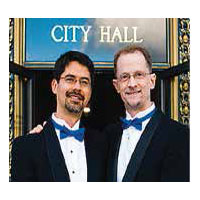 By John Lewis and Stuart Gaffney–
By John Lewis and Stuart Gaffney–
Years ago, at SF MOMA’s retrospective of the work of Japanese conceptual artist Yoko Ono, we remember climbing a tall ladder, and then using a magnifying glass to read a word, written in tiny letters on a piece of paper suspended from the ceiling. The word was “YES.”
Ono first exhibited the piece at a 1966 gallery show in London when John Lennon, whom she had not yet met, walked in, climbed the ladder, and read that same word. In Lennon’s words: ” … in tiny little letters it says ‘YES.’ So it was positive. I felt relieved. It’s a great relief when you get up the ladder and you look through the spyglass and it doesn’t say ‘no’ or ‘f–k you’ or something. It said ‘YES.’”
Of course, Lennon and Ono’s collaboration went on to become legendary. For us, Ono’s work illuminated the vitality of hope, engagement, optimism, and yes—imagination. Five years later, Lennon inspired millions for generations to come by singing: “Imagine all the people living life in peace. You may say I’m a dreamer, but I’m not the only one … .”
Indeed, he was not. Lennon attested that Ono was responsible for much of the song, and in 2017, she finally received the co-writing credit he had wished for her to have.
This holiday season we find ourselves pondering the wonder and power of imagination. The holidays are perhaps the time when many Americans embrace imagination most, in particular the idea of an old, plump gentleman dressed in red, who resides at the North Pole.
The poet and novelist Alice Walker declared, “I have fallen in love with the imagination. If you fall in love with the imagination, you understand that it is a free spirit. It will go anywhere, and it can do anything.” The painter Vincent Van Gogh advised: “Do not quench your inspiration and your imagination; do not become the slave of your model.” The writer Maxine Hong Kingston keenly observed, “A good strong imagination doesn’t go off into some wild fantasy of nowhere. It goes to the truth.”
Imagination provides us the opportunity to recognize truth and find hope that might be less accessible if we limit our minds to analysis and reason. One of the greatest scientific geniuses of all time, Albert Einstein, proclaimed: “Imagination is more important than knowledge. Knowledge is limited. Imagination encircles the world.”
And imagination can be transformative in politics and activism. It has played a pivotal role in the LGBTIQ movement. Thinking over the past year, who could have imagined that Pete Buttigieg, the openly gay Mayor of South Bend, Indiana, would be a leading contender for the 2020 Democratic Presidential nomination? Pete and his husband Chasten could. Forty years earlier, Harvey Milk imagined himself on the San Francisco Board of Supervisors, and with a lot of work by thousands inspired by a dream, he won election.
On February 12, 2004, Gavin Newsom, in allegiance to the Constitution but in defiance of state law, imagined San Francisco as a place that recognized the truth of the dignity and equality of same-sex love and marriage equality for all. He was able to make that truth a reality for 30 days in 2004, and thousands from around the globe, including ourselves, responded.
When those marriages were nullified six months later, who could have imagined that just over a decade later the dream of nationwide marriage equality would become a reality? Although devastated, many of us could. The experience of that 2004 dream come true inspired countless people, not just in San Francisco but across the country, to work for lasting equality.
Today, LGBTIQ activists in China are imagining their country passing marriage equality legislation, even as Chinese President Xi Jinping presides over a political and cultural crackdown not seen since the 1989 Tiananmen Square Massacre. This fall, Chinese queer activists launched a grassroots campaign encouraging the community to submit their personal stories and desires for equality to the national legislature during the authorized public comment period for an unrelated marriage and family code bill. Upwards of 200,000 people appear to have submitted comments.
Imagination abounds in the LGBTIQ community—from artists, writers, musicians, and filmmakers to drag performers to the Radical Faeries and more. It is foundational. Queer people come out because we imagine a better life no longer hiding or repressing our sexuality. Transgender people take courageous steps because they imagine the wholeness they will feel when their body matches their gender. Our community’s political engagement and activism are founded not just on our desire to make our own lives better, but also on the dream that LGBTIQ youth growing up will not face the same challenges we did.
This year, we’re asking Santa to bring us the gift of letting our imaginations run wild to discover new truths and possibilities. We wish you an imaginative holiday season and New Year 2020!
John Lewis and Stuart Gaffney, together for over three decades, were plaintiffs in the California case for equal marriage rights decided by the California Supreme Court in 2008. Their leadership in the grassroots organization Marriage Equality USA contributed in 2015 to making same-sex marriage legal nationwide.
Recent Comments